IMDb meta-data is runtime is 1 hour and 21 minutes, rated 5.5 by 535 cinemitizens
Genre: Sy Fy
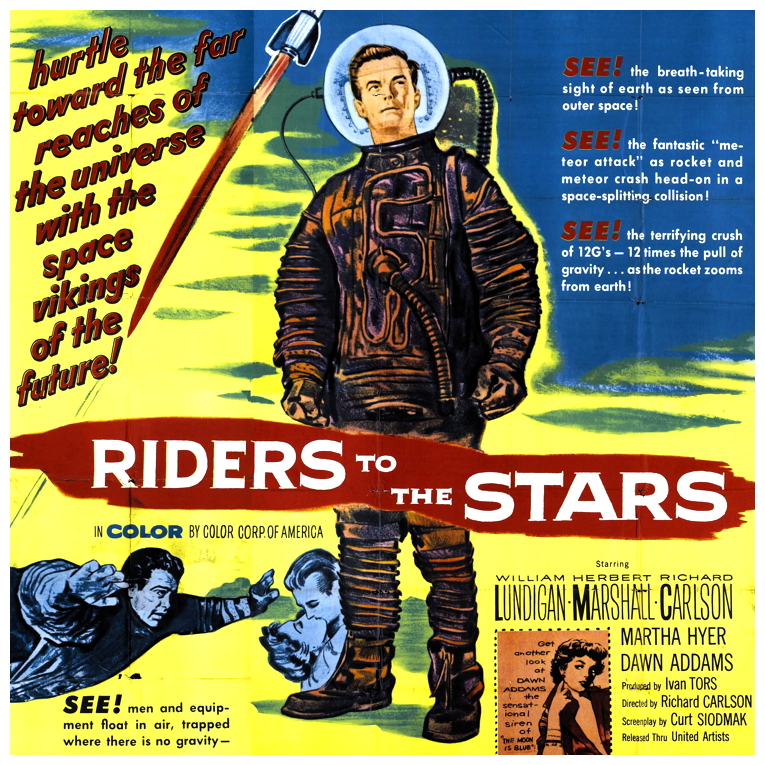
Verdict: Stolid.
Setup? Things are going badly for the US rocket program, despite the best efforts of Herbert von Marshall. The rocket go up whole and then come down in pieces. (That was true, about sixty in all.) What is happening? What is to be done? Herbie V ponders these questions behind his owlish glasses with his team in the heart of the darkest California desert.
Then Ice Blonde concludes the rockets have to be shielded from the cosmic rays that are disintegrating the hulls. ‘Ah ha,’ mutters Herbert, ‘Yes, we have to do this before THEY do.’ This would be the Red THEY of the Coldest War.
Now the talk shifts to what kind of shield? Meteors rocket around without disintegrating until they burn in the Earth’s atmosphere. They must have a protective coating in space which is lost when entering the atmosphere. What we need is a meteor from space so we can examine its protective coating of carbonised bumpkin. Well, why not, the meteor shower is in every Sy Fy scriptwriter’s play-book. (Of course, this line of reasoning makes no sense since the rockets will have to pass through Earth’s atmosphere twice. If the atmosphere strips the coating off a meteor on entry, it will have two chance to do that to a rocket.)
Rockets they have aplenty from the bottomless budget allocated to get ahead of THEY. Mission they have, lassoing some meteors in the wild. Now they need some rocket boys to sit atop of tons of volatile liquid nitrogen that can go bang at the spark of a split infinitive. Herbie has been sending white mice — discrimination against brown mice? — up in rockets to study weightlessness but he is pretty sure the Aryan mice are not up to meteor-grabbing. Why not use a computer? Because in 1954 a computer was a mile long and weighted more than a Hollywood actor’s ego. Ok, it has got to be people, well, as of the times, men.
And not just any men but a carefully selected set of Hollywood supporting actors who are chosen by the whirring of computers scanning punch cards. (Be glad if you don’t know what a computer punch card is.) About twenty supporting actors and the leads are invited to join a secret project. Some say ‘Buzz, off.’ Others rush to the door to escape the unwanted consequences of a wanted act. Others go as relief from the boredom of life on civie street. Because it is a curious offer. Because it must be important. Because it is on the way to the pay office. Because the alternative is another McKinsey training seminar. And finally because the script says so.
The twelve who said ‘Yes’ arrive, all wearing neck ties and business suits and about half wear hats. Several smoke pipes and more than half of the others are sucking cigarettes. Is it any wonder lung cancer surgeons look back on the old days with nostalgia.
Next comes the rigorous testing for the mission. It is in two parts, the first psychological and the second physical. The psych test is fiendish. They are seated in a meeting room and told that the training session will begin shortly! There is no escape; the door is locked! And they wait. For hours. Hours. Hours. What to do? Light up. Everyone smokes. To some perhaps lung cancer was preferable to enduring yet another training session given by twenty-year olds who never use the system and have no corporate knowledge or interest.
James Best goes all whiny and storms around. Another one paces a hole in the floor. A third smokes three times faster than anyone else and disappears behind a midden of cigarette butts. A fourth goes all WTF and pounds on the door. While others sit calmly waiting, napping, talking about sports, or thinking about that Ice Blonde, as were the fraternity brothers.
Sorted. Whiny James (who is he best whiner in the business) is out. Ditto both Pacer and Pounder. Smoker though seems normal enough once he is disinterred from the ashes. How he is going to smoke in space is one of the imponderables that does not get pondered.
Next comes the needles to start the physical examination. Sight of the needle sends others packing. Then they go to the fairground and ride around to test stamina. Next comes the equipment training and more are winnowed out until only four are left. Then for reasons the fraternity brothers missed another one leaves. Some testing! They started with 150 million people and got down to three.
The rockets have scoops which were later passed on to Hugo Drax. But for now our trio go meteor hunting in the heart of darkest outer space. Whew. One bites off more than his scoop can chew and blows up. His skeletal face in a pressure suit floats by the window of a second scooper who panics and tries to bail out. So much for the rigorous testing program. Sight of the first stiff and he wants to bail, scoffed the fraternity brothers, while cowering behind the sofa in fright. Only the stolid William Lundigan prevails and returns to save US from THEY! That melts Icy.
This the third of Ivan Tors’s trilogy about the Office of Scientific Investigation, and as usual Tors tried to get some science into the story. Wacky though it is.
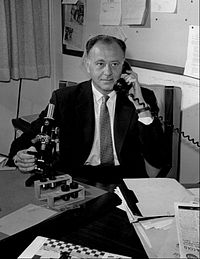 Ivan Tors. Note the microscope. [Witticism needed for caption.]
Ivan Tors. Note the microscope. [Witticism needed for caption.]
Ergo the computers look like computers of the day and not Christmas toys. That is bland with nary an array of blinking lights to keep the audience awake. There are no voltmeters, retorts, or Tesla coils passing as advanced scientific equipment. The stock footage of rocket launches is well integrated into the props and effects. The pressure suits the flyboys wear are the real thing. The term ‘astronaut’ is not used.
There are no villains except for the off stage THEY. Space flight is hard enough without villains or papier-mâché spiders. Overcoming the laws of physics like gravity takes all the ingenuity there is. I certainly feel that way many a morning.
The fairground ride was in fact a centrifuge at USC which Tors got permission to use.
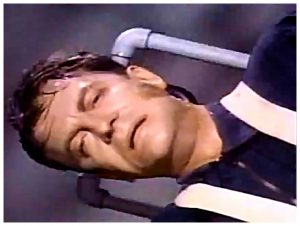 Lundigan getting G-forced for real.
Lundigan getting G-forced for real.
Some of the other effects are not as good. The wires in the weightless scenes are visible.
While all the potential fliers are men, the Ice Blonde comes up with the core idea, and she is a mathematician not a coffee-maker. Like everyone else in the script she is a Doctor and the title is uttered at least fifty times by one character or another about or to another. Fifty at least, because the fraternity brother who was counting ran out of fingers (don’t ask) at that point. Of course, Icy is there to pair off with Stolid Bill though how he could melt her is a tribute the the screen writer’s imagination. By the way the writer is the redoubtable Sy Fyian Curt Siodmak. All hail!
Speaking of Bill, well, it is hard to speak of him, because he is soooo bland. But there is a light in his eyes that sets him apart from the catatonic John Agar whose existential being was eroded by the hundreds of terrible parts he played until there was nothing left beneath. Bill is just attractive enough to be noticed by women but not so damn handsome as to irritate men. That middle way would seem to be his major attribute. He is calm, reassuring, steady, and stolid, and he had that mellifluous voice that got him started in radio advertising when his football career ended.
Having been a BMOC at Syracuse University he had a knee injury that made him 4F in 1941 but he volunteered anyway and in time served. That he volunteered voided his film contract and his career never quite recovered from that. Was he brown-listed? Did such tacky things happen in Tinsel Town? Most of his post-war career was in television. He was the one constant in the very realistic series ‘Men into Space’ (1959-1960) over thirty-eight episodes.
Richard Carlson of much Sy Fy fame is there as second lead and he got the directing credit in a deal with the producer Tors, though this is much discussed in the Cine Nerd Cyberdom. He is another Mr Ordinary, but with an intellectual and reflective mien that served him well. He had hoped to go into directing and this was his first outing, which was made difficult by playing in it as well, but it was a chance to try and he took it. He directed television episodes in the 1950s and 1960s including one starring Bill in ‘Men into Space.’
Hidden in the Ice Blonde’s one hundred and six credits on the IMDb is one star turn in ‘Some Came Running’ (1958), where she had more to do than be eye-candy. She is by the way Martha Hyer whose voice alone melted four of the fraternity brothers. Here she is endowed with sense, poise, intelligence, and purpose. Later she had the screaming, tripping, and fainting duty in ‘First Men in the Moon’ (1964) usually allowed to women in Sy Fy of the era.
Herbert Marshall was owlish in ‘Gog’ (1954), reviewed elsewhere on this blog. After having a leg amputated in Great War, he gave up a career as an accountant and took to acting. His first and most sustained act was to develop a walk that concealed his prothesis so well most did not know he had it. Ivan Tors thought his walk, which he had noticed, was an affectation for the role, only to be astonished later to see the wooden leg. That wood was a constant source of pain which Herbie doused with whiskey at all hours of the day and night without slurring or forgetting his lines. Thus did the show go on.
Month: July 2018
‘The Murderer in Ruins’ (2016 ) by Cay Rademacher
Genre: Krimi
GoodReads meta-data is 334 pages rated 3.9/5 by 539 litizens.
Verdict: Compelling.
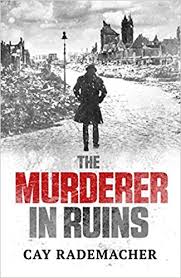
January 1947, Hamburg Germany is city in ruins and a city of paradox. It is depopulated and overpopulated. Depopulated by the war, by the bombing, by the deprivations….tens of thousands died, many who could left. Overpopulated by Displaced Persons – millions of them roaming Europe at the time, camp internees, returning German POWs, German refugees from the East, Russian deserters, and more.

Because it was a major seaport on a major transport waterway, the Elbe, because most of the U-boats were built there, because it lay within range of the RAF, Hamburg was subjected to constant air attack for five plus years. From July 1943 the air raids were obliteration bombing aimed at the industrial and attendant working class areas of Hamburg. Because precision bombing was then, as now, largely a fiction for popular consumption, the bombs fell where they may.
What became the British Army of the Rhine occupies Hamburg and environs with an experienced colonial hand.
Then came the hard winter in which the story is set. Both the roads and railroads were badly damaged by bombing, and now the weather has rendered them useless. The trains cannot run. The roads are impassable. The Baltic winds drive the -25C temperature into the bone. It has been much too cold to snow for weeks. In this weather the Brits mostly stay indoors, near the heat. They have plenty of everything, and stealing from them is crucial to the blackmarket.


Much of the population is homeless, living in basement ruins, lean-tos, or cobbled together Nissan huts surplused by the Brits. Most are dressed in the rags, clothes they have had on since 1944. Most wear all their clothes at once for warmth, but also to keep others from stealing them.
In the last years every tree has been cut for fire wood. Coal is unknown. Medicine is beyond price. With the closure of transport for weeks, neither wood nor coal can be trucked in. Food is vanishing. Everyday people die in the street of starvation, malnutrition, exposure, disease and simply freeze to death.
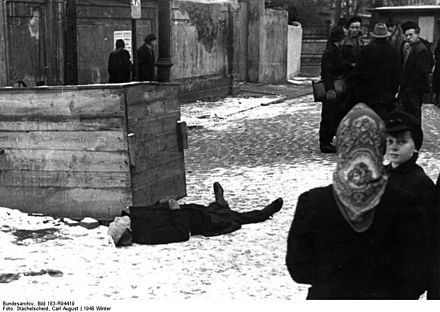 Death in the streets. Starvation, malnutrition, and disease.
Death in the streets. Starvation, malnutrition, and disease.
The Third Man would find this all familiar territory.
DeNazification has gone full tilt. Expelling Naziis from the police, courts, law, hospitals and so on. Necessary but disruptive to the workings of the city. Expatriate Germans who got out are returning to this new world, but many are out of depth in this situation. False identity papers are a thriving black market. Since few paper records have survived the firestorms of the bombings, claiming identity is common.
Could things be any worse? This nightmare world is far more disturbing and disjointed than any dystopia conjured in the Sy Fy films treated on this blog. This environ and the city of Hamburg itself is the major actor in the novel.
Then it gets worse when a murder victim is found, naked and frozen into the surface in a bombed ruin. Then another, and another. Can it get any worse? Yes. The first victim was a young woman. The second an elderly man. The third a child. The fourth, an older woman. Each garrotted, a method much favoured by Naziis as degrading and economical.
Inspector Frank Stave with a stiff leg that kept him out of the Wehrmacht and much baggage is landed with the investigation, aided by a British liaison officer, and a new vice detective. His loyal office assistant does what she can. There are wheels within wheels in this circle.
The strength of the book is the context. The ice freezing on the windows of unheated bedrooms. The flapping of roof tiles in the Arctic gusts. The odors which penetrate even the sub-zero temperatures. The desolation of the streets. The exhaustion of the people. The flow of humanity in the Displaced Persons of every nation, race, and creed. Everyone is suspicious and fearful of everyone else pace Thomas Hobbes’s state of nature. The desperate efforts of Jews to get to Palestine. Ominous rumbling about what the malevolent god in the Kremlin might do next.
The author is no apologist for the Reich.
 Cay Rademacher
Cay Rademacher
The Hunger Winter of 1946-1947 was bad all over Northern Europe, made worse by the destruction visited by the Naziis in Norway, Denmark, Poland, Netherlands, and France. As Stave muses, we brought this on ourselves and now we have to endure it.
On the terrible conditions in Germany read Stig Dagerman’s ‘The German Autumn’ (1947), though when I read this years ago while travelling in Sweden I found it to be an apology for the Reich.

Back to the book in hand, in contrast to the environment, the characterisations are not particularly compelling, and as is usual there is far too much sympathy-jerking backstory for Stave. This volume is the first of a series and I will certainly try another.
I quibbled about some of the terminology. Those who informed on others were styled by several characters as ‘grasses’ a British term of the 1960s. Would a German have used that expression in 1947. There were other instances of the same sort that distracted this reader.
‘Another Earth’ (2011)
IMDb meta-data is runtime is 1 hour and 32 minutes, under-rated at 7.0 by 82,620
Genre: Sy Fy and empathy.

Verdict: Recommended for adults.
An intense tale of hubris, tragedy, and redemption with a blinder at the end.
It charts the budding relationship between a distraught man and the guilt-ridden girl, he nearly psychotic and she certainly neurotic, each with good reason.
What’s to like? (In no particular order.)
– the living Jupiter in the opening sequence.
– the video boxing.
– the essay about the losers being the people who go first.
– the other earth hanging in the sky ever an invitation to think twice.
– the chance meeting with a one-time high school classmate at the convenience store and his incomprehension that she is a janitor and her directness in saying so.
– the working class side of New Haven in the fall and winter as a setting: Barren, foggy, hard, bleak…. Yet the spring will come.
– the saw concert for one.
– that there was no resolution at the end just more questions.
And I really liked the very end. It was quite unexpected and yet dead obvious, both at once. If only…..
Cryptic and enigmatic at times, but it assumes an audience of adults who will not implode if everything is not rammed home with shouting, primary colours, and capital letters, an audience of adults who might later think about what they have seen in this empathy machine. The air of mystery that hangs over the film adds to its forlorn appeal. For example, what are we to make of the elderly janitor? His suicide attempt makes no sense and does not relate to either the major theme (the other Earth that is within us all) or the minor theme (the relationship of the wounded man and broken girl).
The rough edges show in some of the photography and camera work. Please use a tripod in the future.
The idea of another Earth figures in ‘The Journey to the Far side of the Sun’ (1969), reviewed elsewhere on this blog. But there is no other point of comparison between the two movies.
I cannot recall what prompted me when I bought on iTunes except that it was Sy Fy just before leaving for Honolulu in August 2012, and watched on the unendurable (see next paragraph) flight to Honolulu on my own before I went on to Omaha. Loved it. Put an edited version of these notes on IMDB and read Roger Ebert’s laudatory review. I posted a review on the IMDb but forgot to put it on the blog, until now when I went looking for it.
This flight to Honolulu promised to be unforgettable because my Economy seat mate wanted to tell me his sad life story at full volume even before seatbelts were fastened to make me a captive audience. Ten hours of that might have been fatal for one of us. But immediately after take-off a cabin steward said I could [hint, should] move to an empty row up ahead. There is a god. I did so, though even at that remove I could still hear my former seat-mate going on about his woes to those sitting behind him, and they encouraged him to go on, and on, and on, and he was still at it when those ten hours later we stood at the baggage carousel in Hono. Why this cabin steward picked me is the miracle in this story.
I read some of the one-star reviews on the IMDb. What a world! Lifeforms below Republicans exist. Who would have thought that was possible.
‘The Man from Earth’ (2007)
IMDb meta-data is runtime of 1 hour and 27 minutes, under-rated 7.9 by 153342 cinemitiziens
Genre: Sy Fy.
Verdict: Unique.
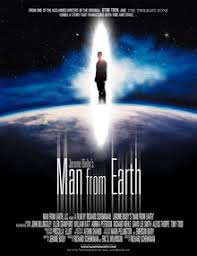
Dr John is leaving town, having resigned from the local college where he taught for several years. He will pack up and leave without fuss or fanfare, but…..
Friends arrive bearing beer for a surprise send-off party. They gather: a biologist, an anthropologist, a geologist, an historian, a theologian are among their number. Some are solo, and others have paramours with their own academic fields. They sit around, joking, talking about sports when one notes that it is Columbus Day. (That used to be a national holiday in honour of Christopher Columbus blundering into the West Indies.)
Warning SPOILER. To read on is to find all.
At which point John says, ‘I had a chance to sail with him’…and goes on to describe Columbus, the ships, and crew and his fear of a flat earth which precluded going along. The others sit in silence, surprised, bemused, anticipating a punch line, stunned, but John, though low in key, is serious, sustained, and systematic.
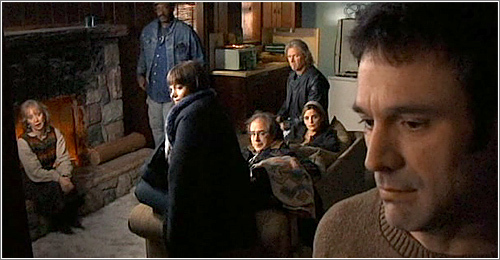
His mien is shy, diffident, reluctant even. Yet he goes on.
He says he is a very old man, despite his appearance of a thirty-five year old. In fact, he estimates his age at 14,000 years. That is right 1 4 0 0 0 years. [Think of all those IRS returns.] Estimates, because there is no 14,000 year old birth certificate.
When he first noticed others ageing and dying, he began to realise slowly that he was different. He learned that in small tribal societies being different was dangerous and moved on, and on. He has since travelled the world slowly and learned to move on before others noticed that he does not age. He has been injured. He has been ill, but he has always recovered.
He has no superhuman powers. No special insight. He is just one individual and he only grasped the significance of many things later when he read about them, e.g., Columbus. At the time, Colon was just another Genoaese adventurer going West instead of East. When Genoaese sailed East they were pirates preying on Venice and Constantinople. When they went West they were explorers.
The assembled scholars do what scholars do best — ‘Make snide remarks and quibble,’ chorused the fraternity brothers — no, ah, yes, well they do that, but they also ask questions, many of them, and he has answers. All simple. He has lived a long time and learned a lot but he has forgotten most of it over time. He has no superhuman mental powers. He can be hurt. If shot, as one proposes, he will die. It was a scary thought that the dean carried a gun. The fraternity brothers have pledged themselves to be more respectful.
Has he met others like himself? Maybe, he says. Not sure. Not the sort of thing to talk about with strangers in an elevator, and as he is always moving on, he is usually with strangers. Of course the premise of the story is that he has chosen to tell these people who have surprised him with this gathering.
Does he have proof? No more than any one of them. A Driver’s License. Not a stone age name tag or SSN 000000000001.
Isn’t he weary and bored? Well, yes, but that is why has earned so many degrees over the centuries and moving on is always a stimulating challenge.
He has mundane but credible answers to the questions they throw at him. The night wears on. The beer flow is exhausted and the whiskey bottle ebbs. The nods begin.
Finally, in anger one guest tells him to stop teasing them with this hokum. And he does. He says it was all a lie, all a joke that got out of hand. Everyone laughs in relief, especially the theologian for whom an immortal is a god. The party members leave. All but two.
One of the two remaining asks him, ‘Why did you lie?’
Which lie? Clearly the interrogator believed the super Methuselah story and means the lie that it was all a joke. The truth is that he is 14,000 years old. [Image his pension payout.]
Now I would have left it there. But the screen play has other elements which are well played but which cut across the intellectual plane of the story. One is about the historical Jesus and two others are about emotional relations to these last two characters. Well played though they be, they are superfluous. And the emotional connections defuse that last ambiguous remark about which was the lie.
The screenplay by Jerome Bixby is a corker, but he did not live to see this pet project to completion, having written the first draft in the 1960s. His other credits include ‘Fantastic Voyage’ (1966), and many episodes of ‘Star Trek,’ ‘Twilight Zone,’ and ‘Men into Space.’ His Sy Fy CV is rich. The direction of Richard Schenkman is invisible. That is high praise for what is a one set, stagnant play. He injects just enough movement and establishing shots to retain visual interest and to remind viewers that nature is indifferent.
It is sometimes performed as a stage play. All it takes is a few chairs and some players.
The screenplay passes lightly over love and sex, though not entirely, but it does completely elide language. Has this travelling man from India to Indianapolis learned all the languages in-between. Does he retain the Latin Columbus spoke? Urdu? Aramaic? Greek? Gypo? Arabic? Hindi?
David Lee Smith carries the picture as ‘The Man from Earth’ with a subdued intensity, though what the title means remains a mystery to this viewer. The ensemble cast includes the marvellous Dr Phlox from ‘Star Trek: Enterprise’ and William Katt, who was memorable in ‘Big Wednesday’ (1978), made a return to my consciousness here with his soul patch.
‘Atomic City’ (1952)
IMDb runtime is 1 hour and 25 minutes, rated 6.2 by 292 cinemitizens.
Genre: krimi but honorary Sy Fy, as below.
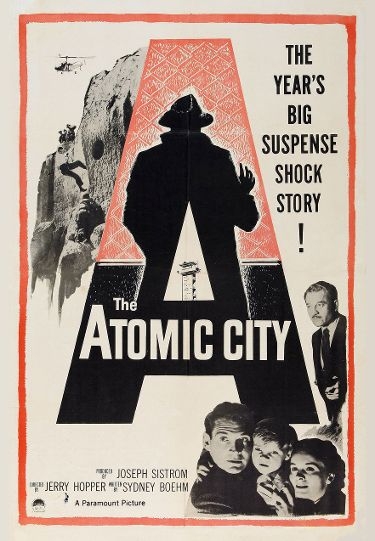
It opens with Trinity at 05:29 on 16 July 1944 in the Jornada del Muerto desert. In just over three weeks another gadget destroyed Hiroshima.
The Atomic City is Los Alamos, shown here enclosed by cyclone fencing topped with barbed wire, the perimeter patrolled by armed guards with dogs, entry and exit is tightly controlled. (Much more tightly than the Brits did in ‘Spaceways’ [1953]. Much.) Inside the wire no one talks about the work but everyone works on weapons. Secrecy is all.
 A part of Los Alamos in 1952.
A part of Los Alamos in 1952.
Top Scientist is distressed by an accident at work in which a worker was badly burned. That the burns are very serious is made clear. At the time the official line was that worries about radiation were evil Commie propaganda to undermine Yankee-doodle nuclear research. While no fuss is made, any viewer, apart from the fraternity brothers, can see these burns are likely fatal.
His home life is displayed with Corporal Rusty much in evidence. The tone of the film is set by Rusty when he says, ‘if I grow up,’ and is corrected by his mother to say ‘when I grow up.’ But he lapses back to the subjunctive ‘if.’ That word ‘if’ conjures the threat nuclear war and it is striking. Well done, screenwriter Sydney Boehm, who also did ‘When Worlds Collide’ (1951).
Mrs Top Scientist, and that is how she introduces herself, worries that Los Alamos is a bad environment for Rusty surrounded by all these mad scientists dedicated to blowing things up with the prospect of more burns. Until the Big One.
 Published by Katrina Mason in 1995, recollections of some who lived there.
Published by Katrina Mason in 1995, recollections of some who lived there.
Top points out that there are 4000 other children, the schools are excellent, there is no crime, and the newspaper is delivered on time. Enuf said.
Nonetheless it is also true that every time he steps out of the house he is followed by security officers who dog his every step, the mail is censored, the telephone calls tapped, the kitchen cupboards bugged. That he has to show his pass at every corridor and so on. He chafes at this while accepting its purpose. Inside the wire it is a benign police state.
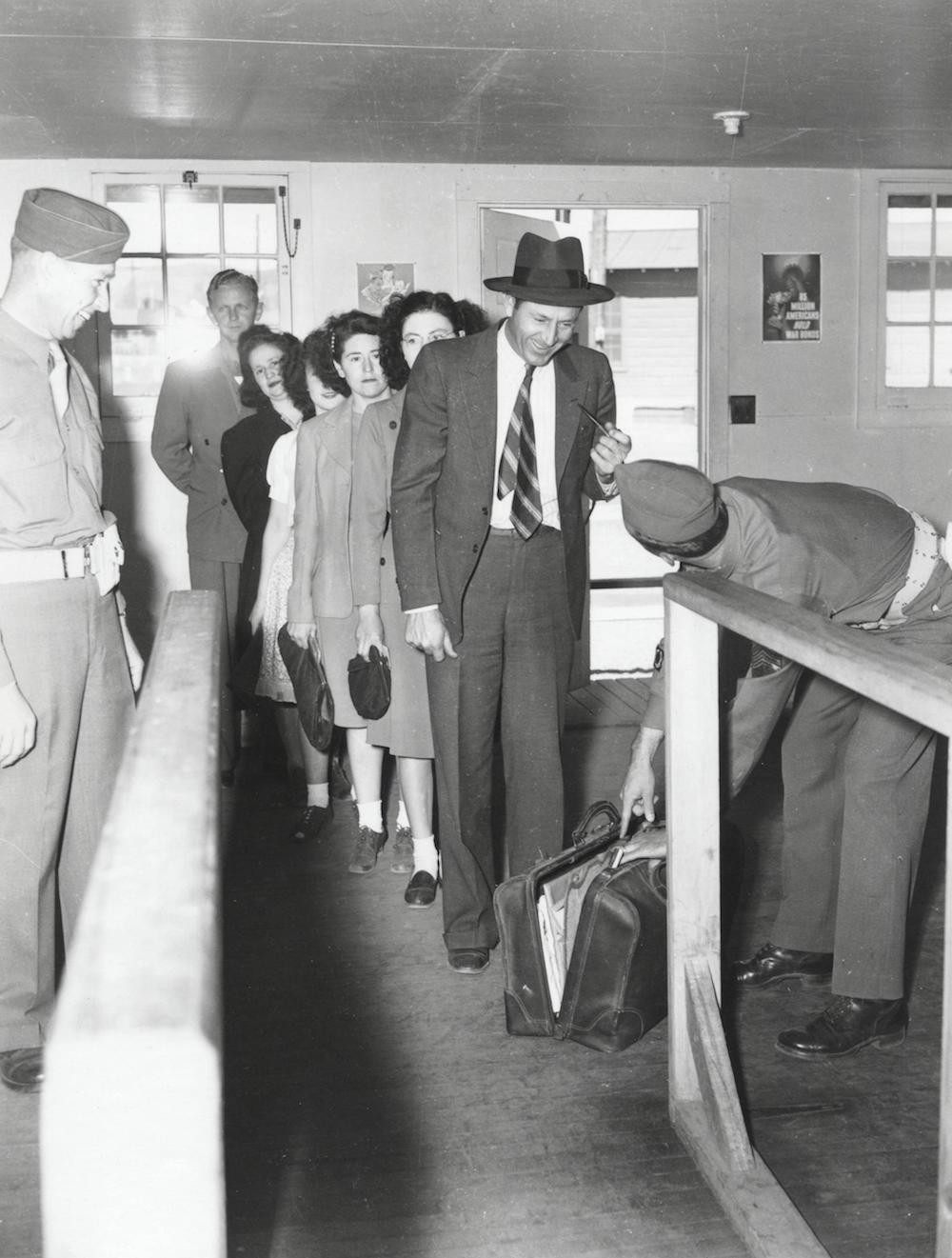 Everyone and everything is searched even inside the wire.
Everyone and everything is searched even inside the wire.
Top accepts this situation as necessary and in this acceptance he is far more mature than many of the scientists who developed the bomb there a few years earlier.
Rusty goes on a school outing to Santa Fe where THEY snatch him. THEY are RED. What is interesting about these Reds is that they are all homegrown. Not a creepy Eastern European accent among them. They want to extort atomic secrets from Top in return for Rusty’s safe return. Top and Mrs are distraught and try to go it alone, as per the instructions of the Red Rusty-nappers. See ‘Tobor the Great’ (1954) for a parallel plot done badly, reviewed elsewhere on this blog, where Steven Geray added menace with his accent.
But the ever vigilant FBI agents — well it is a work of fiction, hooted the fraternity brothers — have already noticed Rusty’s absence and spring into action, led by Doc Adams.
The Reds are ruthless and murder their own to cut the trail. Bad Reds!
When the FBI agents finally arrest a suspect, they must not waterboard him, because if they do, then they become just like THEM, says one agent to another in restraint. This tension is one of themes in the film. To defeat the merciless totalitarian Reds, the Yankees may have to be equally totalitarian and merciless.
In the story the tension is resolved in another good scene. When Top confronts the suspect and says his name. The gloves are off! Out comes the waterboard off camera.
Aside, early on we have a scene at a minor league baseball game, probably the Lost Angeles Cubs in those days. It is a nice bit of location shooting that is done very well. But what is striking at this remove is that the crowd at the game is integrated, conspicuously so. Check the date, 1952.
While we see much FBI effort, there is no result apart from the little info Top beat out of the suspect using a waterboard as a cudgel. And that goes nowhere.
Meanwhile, we see a grimy Rusty imprisoned by the All-American Reds in the Puye Caves of the cliff-dwelling Anasazi People. He is ever so polite, but even so we can see he is sizing up the situation and does not believe a word of the assurance the villains give. Remember ‘if I grow up.’ He does.

When the Reds are busy planning world domination (but not smoking), he sneaks off, and makes use of the cave system to worm his way into tunnels the beefy All-American Reds cannot enter. Nice use of the location with some grand vista shots.
It must have cost a packet at the time to hoist the camera to the top of that mesa. Equally it must have taken an effort to film at the baseball game with a camera the size of an automobile.
While all the principles are white-bread there are Latinos, Indians, and Blacks in the background at the ballgame and in Santa Fe. Even that little is rare for the time when Hollywood was All Aryan.
In addition to Mrs Top who does a lot of knuckle biting, there is a sassy school teacher. They add emotional depth, though Top is good at distraught, too.
There is cigarette smoking, to be sure, but it is not quite as overwhelming in this offering as it sometimes is. Hence the parenthetical remark above.
Honorary Sy Fy when it showed up in searches for Sy Fy because at the time anything atomic evoked Sy Fy. In addition, Top went on the beat the Martians in the next year and later to save the world on the 27th day.
‘The Night the World Exploded’ (1957)
IMDb runtime is a brisk 1 hour and 4 minutes, rated 5.2 by 330 cinemitizens.
Verdict: The end of the world. Again.
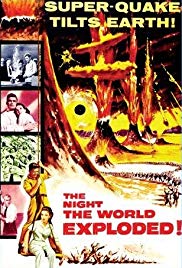
The setup? Dr Drone beavers away in his laboratory to invent….a quakometer to predict earthquakes. He does. It does. We all know whose fault that is: San Andreas! That’s whose.
No sooner does Drone develop a drum printer to predict earthquakes than it predicts a big’un and soon. Efforts to persuade anyone to believe in science fail. Faux News rejects his data as fake. It is ever thus.
When the quakes start as predicted panic stations ensue. Faux News blames the quake on immigrants.
In this work of fiction the script gives public officials some credit for preparation and disaster relief. As if, once the budget cutters got done.
Off to Pasadena to consult the Datatron computer.
 Datatron 205. (It took 204 others to get it right. Is that encouraging?)
Datatron 205. (It took 204 others to get it right. Is that encouraging?)
Datatron confirms Dr Drone’s prediction.
To get to the bottom of quakology Dr Drone takes his comely offsider and assorted extras to Carlsbad Caverns. ‘Unknown World’ (1951) boldly went to these Caverns first and is reviewed elsewhere on this blog.

Only down there can the rotary printer predict accurately. The news is bad. Very bad. Worse than bad. The end is nigh. The explanation is mumbo-jumbo.
It is element 112, kaboomium, which is about to go critical. The demonstration of popping a balloon of earth convinces everyone to run for cover. Run where? Good question.
Instead Dr Drone coordinates a worldwide effort to quell element 112. They have twenty-eight days, one more than allowed in ’The 27th Day’ (1957), reviewed elsewhere on this blog. All across the world scientists everywhere pass water onto 112 and it relents. The fraternity brothers volunteered to pitch in.
The pace is brisk. The acting is improved by the absence of John Agar. The comely offsider gets on with the job with neither a scream, trip, nor a faint. The sets are miniscule. The authority figures seem authoritative. Dr Drone is committed to the role, as they say on thespian street.
However, there is far too much yakkity-yak. Everyone cooperates. No one nit picks. Quibbles. Back stabs. Undermines. Or any of the other Standard Operating Procedures of life. Nor are there any villains. Not even a Red. Where is the tension in a clicking calendar? Even kaboomium seems pretty sedate say compared to those walking menaces in ‘The Monolith Monsters’ (1957), reviewed elsewhere on this blog.
Curiosity. There is no musical soundtrack. The union missed this one.
‘Thumbprint’ (1936) by Friedrich Glauser
Goodreads meta-data is 200 pages, over-rated 3.74 by 226 litizens.
Genre: krimi, police procedural.
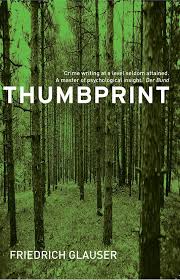
Verdict: a curiosity of the place and time. A forced march to finish it.
Set in the Swiss alps in the early 1930s when radio was a novelty. A local is found dead. Was it suicide or murder? Everyone speaks Schweizerdeutsch in which ‘Chabis’ is an oath.

Not to be confused with Chablis.
Into this isolated mountain top community comes Detective Sergeant Studer from the distant Canton to find out which is which. He takes up residence and observes the locals. The bar owner. The nursery man and his staff. The family of the deceased. Creditors. Trees. Swains. Rivals. That is something like the Maigret approach but the hands of this cuckoo clock are heavier by far. As far as this reader can report no thumbprint figures in the story.
Masochists can find out more than they should know by reading the thirty reviews on GoodReads.
 Friedrich Glauser (1896-1938) was diagnosed schizophrenic, addicted to morphine, dabbled with heroin, and was intoxicated when he could not get drugs. He spent most of his life in psychiatric wards, insane asylums, and prisons. That experience makes him well qualified, ahem, as well qualified, as most journalists, to comment on the human condition.
Friedrich Glauser (1896-1938) was diagnosed schizophrenic, addicted to morphine, dabbled with heroin, and was intoxicated when he could not get drugs. He spent most of his life in psychiatric wards, insane asylums, and prisons. That experience makes him well qualified, ahem, as well qualified, as most journalists, to comment on the human condition.
There are two or three other titles with Studer. They are unlikely to be disturbed by this reader.
‘The Miernik Dossier’ (1973) by Charles McCarry
GoodReads meta-data is 267 pages, rated by 3.87 by 1375 litizens.
Genre: thriller
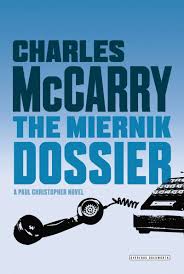
Verdict: Unusual in the telling.
It is deep in the heart of the Cold War of 1959 and the Russkies have their eyes on East Africa. Spy and counter-spy vie to manipulate the natives. It centers around a group from a UN agency housed in Geneva which includes a Yankee doodle, a Polack, a Magyar, a Sudanese princeling, a MI6er, and others who embark on a drive from Geneva to Khartoum. Sure.

While the journey is as fantastic as anything Jules Verne conjured, the characterisations are nicely done. No one is quite whom they seem to be, and yet perhaps they are. Even at the end, it is not at all clear to this reader whether Miernik was a villain, though he certainly was a victim.
What is unusual is in the telling. It reads like a dossier that collects and combines testimony, written reports by observers, diary entries from protagonists, archival material about them, analysis by Langley desk jockeys, wiretap transcriptions, post hoc interviews, radio intercepts, case officer cables, opened mail, entries from the CIA Fact Book, field briefings, and such. While there is a master narrative with an arc, it is by no means told as a story. Though in its own way it is, and the story unfolds in these several different registers. The ending is open, but not empty.
 Charles McCarry
Charles McCarry
This is the first title in a long series featuring Yankee Doodle, namely Paul Christopher. Alan Furst ranks it highly and that persuaded me to give it a try. Not sure, but inclined to try another.
‘UFO: Target Earth’ (1974)
IMDb metadata is runtime of 1 hour and 20 minutes (it seemed longer, much longer), rated a heady 2.4 by 294 cinemitizens.
Genre: Sy fy
Verdict: There is no UFO and little else.
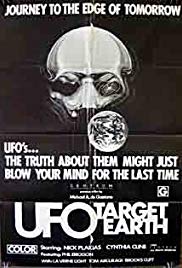
The opening credits are juxtaposed with grainy photographs of ostensible UFOs from the 1940s and 1950s. Then in a prologue we see a journalist with big hair and flared trousers in a double-knit suit interviewing Georgians about UFO sightings and abductions. The interviewees look rural and sound southern. This seemed a reasonable start.
Then the unreasonable set in.
A graduate student, wearing a three-piece suit and necktie with his own office and desk telephone at the University of Gainsville (Florida) makes a telephone call during a thunderstorm and over a crossed wire hears a conversation between a general and someone else about strange goings on.
During this call he has flashbacks to his own childhood in a similar storm, though the exposition is so lame it took ages for the fraternity brothers to realise this was a flashback and not a parallel cut-away. Later these flashbacks might be relevant, but at the time they seemed bad editing.
What to do? He consults his supervisor (bearing a frightening resemblance to what Justin Beiber will become) who wisely tells him to forget it. In the great tradition of student rebellion Three Piece disregards this sage advice, and recruits Mystic to help him get to the bottom of this mystery. Who better than a mystic to deal with a mystery? Mystery? What mystery? The phone call.
He goes to see General, there is only one in all of Florida, who wears an Army-Navy store uniform and who chides him for the liberal ideas of students (in Florida?), and then denies everything. Well he would, wouldn’t he. During this conversation Three Piece represents himself, a lowly grad student, as negotiating for the university. Sure. Even so the conversation is reasonably well written but so slowly executed the suspicion grows that they actors had to be word perfect because their was no dime for a re-take.
It seems there is a long history of electric power disruptions in the area. That the Buford Plant generating station has had some strange accidents. And that the mystic hears voices in the air, and not from a BlueTooth headset.
Three Piece and Mystic trace the voices to the lake. ‘The lake! Gulp. The lake? Yes, the lake.’ This dialogue went on for five-minutes. What they need is proof. Sure, but proof of what? That Three Piece is nuts and Mystic has an ear pod stuck in her lobe?
As darkness falls, they wait. We wait with them. We all continue waiting. That is followed by more waiting.
Then Three Piece also starts hearing voices in the air. He puts on a grey wig like Christopher Lloyd in ‘Back to the Future’ and walks into the lake as the voices tell him he has been chosen, only the fourth to be so honoured in a thousand years. By his sacrifice the world is saved (from the Trumpettes for a time?). We wondered if Virginia Woolf had been so honoured.
The end.
Get it? Get it! No, neither did we. What were we saved from? A sequel?
If the phone call was hot why didn’t the general do something like lock up Three Piece. Like rip his office apart. Like send thugs to warn him off. Like put on reflective dark glasses. Like tell the aliens to look out. Like try to kill Mystic. Come on. This is standard B-movie fare.
Did Florida grad students in 1974 wear three-piece suits? Did scientists team up with mystics quite that readily? Did someone really write that dialogue?
We never see a UFO, nor is there any reason to think that there is one. The voices, well there are other explanations. See a textbook on psychoses for a list.
There are lots of swirling lights to imitate Space Odyssey (1968). Some of the sound track works.
None of it takes us ‘To The Edge of Tomorrow’ per the lobby card. Nor do we broach ‘UFO’s…the truth about them might just blow your mind for the last time.’ Nope. Unblown.
One of the critics linked to the IMDb entry suggests it be re-titled to ‘Target Extreme Boredom’ because it succeeded at that. Amen, chorused the slumbering fraternity brothers.
Then there are the effects, like the boom microphone hanging overhead.
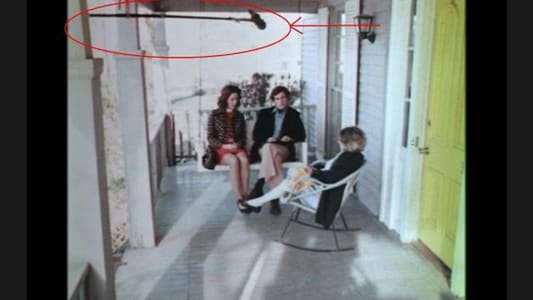
The post-production editing and (dis)continuity render most of it incomprehensible without a script to follow. Hmm. Maybe that would not help.
None of the cast or crew has other listing on the IMDb. Ergo they learned from this experience to go into paediatrics or something.
‘Phantom from Space’ (1953)
IMDb meta-data is 1 hour and 13 minutes of treacle time, rated a generous 4.1 by 818 members of the producer’s extended family over the generations.
Genre: Sy Fy
Verdict: The search for intelligent life on Earth continues, with limited success.
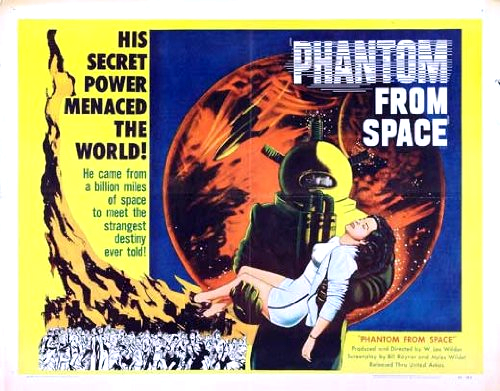
It opens with fifteen minutes of stock footage of radar dishes, screens, technicians who are tracking a flying object, so intones a narrator. The object is making 70,000 miles an hour! It was first spotted over Alaska and then tracks down the Pacific Northwest coast (skipping British Columbia) toward Hollywood. Gulp!
In May 1953 this had to be a Red rover, and not Santa Claus! Stock-footage of F-86 Sabre-jets ascending to meet this Soviet menace! Whoa! Sabres could hit 650 mph. The Red Saucer whizzes past them before the Sabre pilots can buckle a seat belt! What to do! Fear the worst.
Then the flying object slows and drops off the screens near Santa Monica Beach. Nice place.
As this latter event occurs we cut to citizens who find radio reception has been jammed. Some of these citizens go on and on about what they wanted to listen to on the radio. And on. All that jabbering galvanises the Federal Communication Commission to action. (As if.) Its technical vans, recognised by their revolving roof-top antennas drive around Griffith Park while the crew talk to each other. A lot of driving and a lot of talking.
By this time the fraternity brothers were dozing on the sofa. ‘ Zzzzzzzing’ is a direct quotation.
Then a frazzled woman lurches in front of one of the vans and says she and her husband along with a friend were attacked by a man in a diving suit. The technicians leap into action. Yep, they talk some more, but they do radio in the alert and a call for an ambulance. Their radio can, it develops, send but not receive now, like some people. The intermittent radio trouble is well handled in this scene.
Ben Casey’s offsider working his way through medical school as a police officer arrives. Lights up. He finds the husband dead. Story is he picked up a club and swung at the Diver (Phantom to the cognoscenti) who shoved him down, fatally. Cops aren’t buying the malarky and conclude the friend killed the husband for the wife. In a touching bit of dialogue the police keep calling this friend ‘the young man’ when he looks about forty. (He is not listed in the credits so no check is possible.)
While the cops are fabricating a case against ‘the young man’ there is a break-in and fire at the Getty oil refinery. Someone was killed in the fire. But it seems it was started by accident.
At minute 27 second 43 we get the first glimpse of a figure running around the oil refinery in a onesie. This must be Phantom! About time!
The audio had to be turned up to be heard over the snores of the fraternity brothers at this point.
By now the ambulance medicos, army, police, and feds are mobilised in a one camera frame shot, squeezed together, but none of them make any connection between
1) the disappearing Red Saucer,
2) the radio interference, and
3) the Diver.
Instead they grouse about the bad coffee.
Back to the Getty oil refinery. They chase after Phantom in the diving helmet and onesie. Then poof! He goes invisible. Every producer’s dream. He strips off his onesie and helmet and voilà nothing! Instead, wirework opens and closes doors, windows, spins chairs and so. Invisible he eludes the posse. Invisible he eludes a pay-cheque.
The cops, army, medics, and Feds finally realise the obvious at minute 47 second 5 that all three events above are connected. They take the onesie and helmet to Griffith Planetarium to be analysed. Guess they want to hold it up again the stars or something. In the lab (sure) is a woman scientist with her pet dog, Venus. Pay attention because these two are the only ones with any sense. She finds the suit radioactive and dons kitchen washing-up gloves to handle it. This was the official Atomic Energy Commission line at the time. Radioactivity was like poison ivy. Don’t touch.
The helmet, however, is not hot, but its breathing apparatus has unknown gases in it. Hmm. They sit in a cramped office and talk. Talk. Talk.Talk.
Periodically Phantom returns to the lab to inhale some of the helmet gases while the crew sits next door talking. Talking. Talking. Talking. By the way, contrary to rumour one fraternity brother stayed awake and counted forty-seven cigarettes lit by the onscreen cast. During some of the talk all of them are puffing way in a cloud.
Ah ha! There is an ‘Ah Ha’ moment. They will set a trap for Phantom. They set up the Planetarium with invisible eyes on all the outside doors to give alarm when he enters. What if Phantom is already in the building is a supposition none considers. Why they do not use the helmet as bait is down to their stupidity. Into their trap wanders the elderly and annoying journalist after some cheap sensationalism. Nothing has ever changed.
Every time Phantom is present Venus the dog goes ballistic but no one pays that any attention. Yes, Phantom is searching for intelligent life on Earth and so far only the dog passes the test.
While the men smoke and talk, talk and smoke, the Dr Woman goes back to the lab to pour stuff into vials. Phantom comes in for a helmet dose. Now get this.
What is B-movie woman supposed to do at this point? Scream. Faint. Trip. Scream. Faint. Trip. Those are the choices. NOT SO HERE.
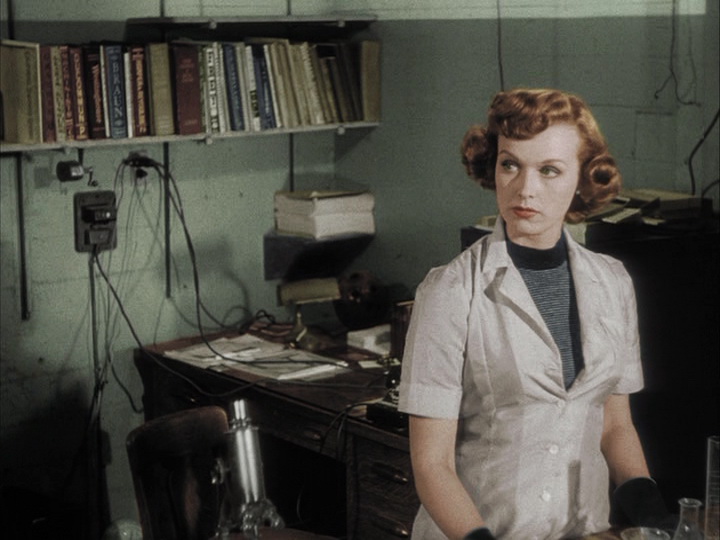 See, she keeps a cool head.
See, she keeps a cool head.
She is frightened when the helmet floats in air, but keeps calm and tries to communicate with the being! She also discovers that he becomes visible in ultra-violet light. She is a thinker. Another one passed the intelligence test. Both females, Venus and Woman, one dog and one not.
Needless to say the lads are unhappy about being shown up and to prove their manliness they set out to chase Phantom around the Griffith Planetarium for about fifteen minutes. We see repetitions of this footage five times. Then bored to death, Phantom runs out of his air and dies.
The end.
Well, it could have been worse. On the bright side, John Agar was not in it. Despite the zero budget it had some good special effects. When the Phantom carries Dr Woman off it is spooky since he is invisible. (In a black suit suit against a black matte.) When Phantom becomes partly visible under the ultra-violet light is good, too. Dick Sands who did the stunt work as the Phantom is good at running, jumping, tumbling, and falling. He does not speak and that saves him from the terrible dialogue.
One of the great moments in reasoning occurs when the talkers, conclude that because Phantom is invisible he must be silicon like glass. Tweet that. Who needs the National Science Foundation with brainwork like that.
It just ends, leaving nothing. There is no conclusion. No explanation. No expectation. No one wonders why he came. What he wanted. Where did he park the Red Saucer on Santa Monica Boulevard. Was he really a Russkie under all that white pancake make up. Nothing. Nada. Zip.
The lobby card is as erroneous as these usually are, written as they are by journalists. Phantom seems to have no power. He does not menace anyone. He was attacked by the husband and defended himself. We have no idea where he came from or why. No one checked the odometer on the saucer. Maybe he came from Outer Schenectady.
W. Lee Wilder produced and directed based on a screenplay by his son Myles Wilder. Yes they are kin of Billy Wilder. Elsewhere on this blog I have reviewed others of Lee Wilder’s oeuvre for which I did homework on the relationship to Billy. See the review of ‘Snow Creature’ (1954).
To some jaded viewers, among whom your correspondent takes a place, it seems the Widers saw ‘The Day the Earth Stood Still’ (1951) and set out to imitate it with a benign alien. But like someone trying to recite poetry phonetically in a foreign language, he had no idea how to intone, phrase, and colour it. Instead it is just a blurt.
The zero budget is reflected in the use of Griffith Park and the Griffith Planetarium which were readily available for filmmakers for years until the welcome mat was worn out. The cramped office scenes were shot in Wilder’s one-man office. Most of the extras were walk-ins recruited at a cattle-call.
